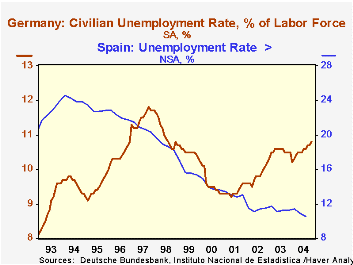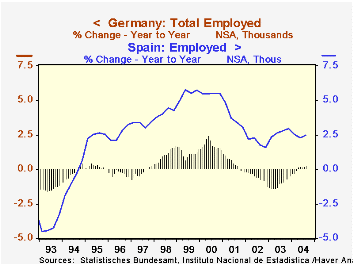 Global| Dec 02 2004
Global| Dec 02 2004German Unemployment Up; Spain's Comes Down
Summary
The unemployment rate in Germany rose to 10.8% in November, the highest in almost six years, since December 1998. The number of people unemployed rose 7,000 in the month, an increase of 2.2% from November a year ago. At the same time, [...]

The unemployment rate in Germany rose to 10.8% in November, the highest in almost six years, since December 1998. The number of people unemployed rose 7,000 in the month, an increase of 2.2% from November a year ago. At the same time, Germany is in the anomalous position that both unemployment and employment are rising. While the number employed dipped 1,000 in September (latest available, also published today), this was the sixth month in which that figure was higher than a year ago, marking a turn from 29 consecutive months of year-on-year declines. At 0.3%, the current gain is obviously not large, but clearly the stabilization is welcome.
In Spain, the labor market is much more vigorous. The unemployment rate there, 10.5% in the third quarter, is nearly as high as in Germany, but it has come down markedly, and the number unemployed for November (which was reported today) is 1.0% lower than the year-earlier level. Jobs are growing, with third quarter employment up 2.5% from a year ago.
It is widely argued that German regulations keep labor costs so high that companies are encouraged to move operations elsewhere. This may be the case, but it's not evident in German labor cost data. Over the last year, hourly compensation per worker in Germany has been virtually flat and labor cost per unit of GDP has actually declined 1.3%. In contrast, these costs are rising in Spain. Thus, labor mobility -- perhaps described better as business operations mobility -- in Europe may be pushing labor costs toward convergence as conditions ease in the high-cost country but firm in the low-cost region.
| Nov 2004 | Oct 2004 | Sept 2004 | Aug 2004 | Year Ago | 2003 | 2002 | 2001 | |
|---|---|---|---|---|---|---|---|---|
| Germany: Unemployment (Thous, SA) | 4,464 | 4,457 | 4,445 | 4,417 | 4,367 | 4,383 | 4,075 | 3,861 |
| Unemployment Rate (%, SA) | 10.8 | 10.7 | 10.7 | 10.6 | 10.5 | 10.5 | 9.8 | 9.4 |
| Employment (Thous, SA) | NA | NA | 38,391 | 38,392 | 38,291 | 38,316 | 38,699 | 38,923 |
| Yr/Yr % Change (NSA) | NA | NA | 0.3 | 0.3 | -0.5 | -1.0 | -0.6 | 0.4 |
| Spain: Unemployment (Thous, NSA) | 1,683 | 1,649 | 1,618 | 1,598 | 1,699 | 1,658 | 1,621 | 1,530 |
| Yr/Yr % Change | -1.0 | -1.1 | 0.7 | 1.2 | 1.3 | 2.2 | 6.0 | -1.8 |
| Unemployment Rate (%, NSA) | Q3 2004 | Q2 2004 | ||||||
| NA | NA | 10.5 | 10.9 | 11.2 | 11.3 | 11.4 | 13.1 | |
| Employment (Thous, NSA) | NA | NA | 17,240 | 17,050 | 16,818 | 16,695 | ||
| 16,258 | 15,946 | |||||||
| Yr/Yr % Change | NA | NA | 2.5 | 2.3 | 2.8 | 2.7 | 2.0 | 3.7 |
Carol Stone, CBE
AuthorMore in Author Profile »Carol Stone, CBE came to Haver Analytics in 2003 following more than 35 years as a financial market economist at major Wall Street financial institutions, most especially Merrill Lynch and Nomura Securities. She has broad experience in analysis and forecasting of flow-of-funds accounts, the federal budget and Federal Reserve operations. At Nomura Securites, among other duties, she developed various indicator forecasting tools and edited a daily global publication produced in London and New York for readers in Tokyo. At Haver Analytics, Carol is a member of the Research Department, aiding database managers with research and documentation efforts, as well as posting commentary on select economic reports. In addition, she conducts Ways-of-the-World, a blog on economic issues for an Episcopal-Church-affiliated website, The Geranium Farm. During her career, Carol served as an officer of the Money Marketeers and the Downtown Economists Club. She has a PhD from NYU's Stern School of Business. She lives in Brooklyn, New York, and has a weekend home on Long Island.





